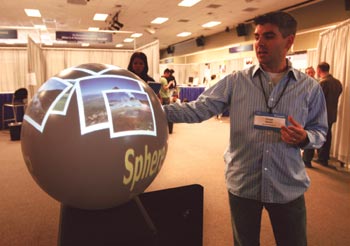Nancy D. Lamontagne, Managing Editor
Researchers at Microsoft Corp. recently revealed a device that allows users to interact with an image, such as a globe, projected onto a sphere. To create the prototype display, the researchers started with a commercially available globe projection system from Global Imagination and then added touch-sensing and other features.
You might think projecting an image onto a sphere and sensing interactions would not be difficult – after all, it’s already possible with flat displays – but the challenges are different for a spherical display. A flat image projected onto a sphere looks distorted in some areas. In flat displays, the projection and sensing can be done from one side, but doing it with a sphere can create dead areas in which interaction cannot be detected or can leave shadows, where users can’t see the image.

Image courtesy of Microsoft Corp.
To deal with these challenges, the Microsoft researchers added an infrared camera that uses the same optical path as the projection, enabling the projection system and sensing mechanism to be enclosed in the base of the device for 360° interaction. They also developed a custom graphics pipeline that prevents distortion in the projected image.
Although this technology demonstrates future possibilities, don’t expect to see sphere displays popping up everywhere. The company has no current plans for commercialization, but if such a display were to be produced, it would be aimed at highly interactive applications. For example, the researchers have developed applications that might be fun or useful for museums, lobbies or information booths, including browsing through pictures or videos, interacting with a globe, finger painting or videoconferencing from several directions.